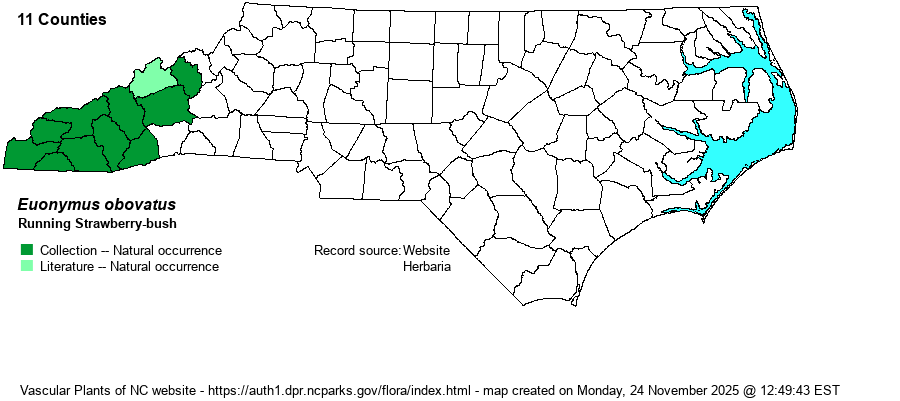| Author | Nuttall | |
| Distribution | Even though this is a Northern species, it is found (so far) only in the central and southern Mountains; there are no known records north of Yancey County.
This species occurs from NY, ON, MI, and WI on the north only to western NC and northern AR. Oddly, it occurs just to the west of WV and VA, yet it is found in western NC, and rarely in adjacent SC and GA.
| |
| Abundance | Generally uncommon to infrequent, and mainly in the middle elevations. It is typically not seen on most Mountain walks within the range. | |
| Habitat | This species favors rich forested slopes, often where rocky. Rich Cove Forests are its most frequent forest type, but it is also found in Northern Hardwood Forests, Boulderfield Forests, and other such fairly moist and cool sites. |
| Phenology | Blooms in May and June; fruits in September and October. | |
| Identification | This is a slender shrub, mostly trailing to decumbent, and rooting at the nodes. It grows to only 2-3 feet long. Its leaves are deciduous, opposite, and slightly serrate. But, unlike the other two Euonymus species, this one has oblanceolate to obovate leaves (widest toward the tip), to about 2 inches long. Its flowers and fruits are very similar to those of E. americanus – flat, 5-petaled pale greenish-yellow flowers and warty pink-rose capsules that crack open to expose the red fruit. Because this species can and does root at the nodes, one may find sizable “patches” of this odd shrub spreading out over a number of square feet of the forest floor, almost smothering out any other plants. | |
| Taxonomic Comments | Weakley (2018) mentions that “our” (NC and eastern TN) plants differ in some ways from those farther to the northwest, and are a bit disjunct; he suggests that they may be separate species.
| |
| Other Common Name(s) | Essentially none | |
| State Rank | S3 | |
| Global Rank | G5 | |
| State Status | | |
| US Status | | |
| USACE-agcp | FACU link |
| USACE-emp | FAC link |

